Description
The imago stage measures 5 to 7 millimetres (0.20 to 0.28 in) and ranges in color from sandy ochre to pale brown.
Phimodera humeralis is found in sparsely vegetated dune terrain on heaths and sandy hills, living on and especially in the sand around Carex arenaria , a 10–40 cm-high grass. P. humeralis is difficult to see, as from a distance they look like small light gray stones.
Adult (imago) P. humeralis hibernate through winter and mate in the spring. The mating takes about 10–15 minutes. The nymphs are 2.5 to 4 millimetres (0.10 to 0.16 in) and are usually found on the C. arenaria grass plants during June and July.
Phimodera humeralis is considered an endangered species, especially in northern Europe.

Ammophila is a genus of flowering plants consisting of two or three very similar species of grasses. The common names for these grasses include marram grass, bent grass, and beachgrass. These grasses are found almost exclusively on the first line of coastal sand dunes. Their extensive systems of creeping underground stems or rhizomes allow them to thrive under conditions of shifting sands and high winds, and to help stabilize and prevent coastal erosion. Ammophila species are native to the coasts of the North Atlantic Ocean where they are usually the dominant species on sand dunes. Their native range includes few inland regions, with the Great Lakes of North America being the main exception. The genus name Ammophila originates from the Greek words ἄμμος (ámmos), meaning "sand", and φίλος (philos), meaning "friend".
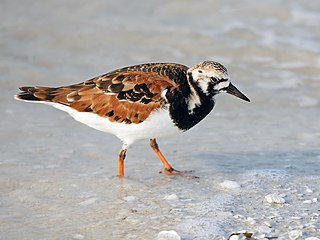
The ruddy turnstone is a small cosmopolitan wading bird, one of two species of turnstone in the genus Arenaria.

The Lulworth skipper is a butterfly of the family Hesperiidae. Its name is derived from Lulworth Cove in the county of Dorset, England, where the first specimens in Great Britain were collected in 1832 by English naturalist James Charles Dale.

The beautiful demoiselle is a species of damselfly belonging to the family Calopterygidae. It is found in Europe, North Africa, and Western Asia. It is often found along fast-flowing waters.
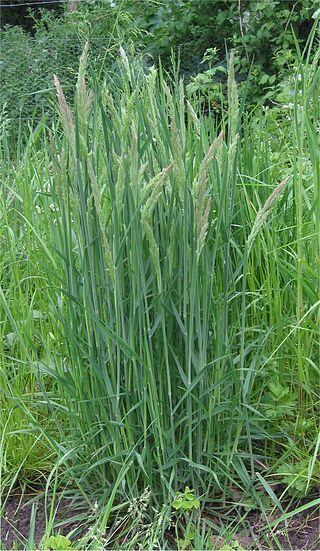
Holcus lanatus is a perennial flowering plant in the grass family Poaceae. The specific epithet lanatus is Latin for 'woolly' which describes the plant's hairy texture. Common names include Yorkshire fog, tufted grass, and meadow soft grass. In North America, where it is an invasive species, names include velvet grass and common velvet grass.
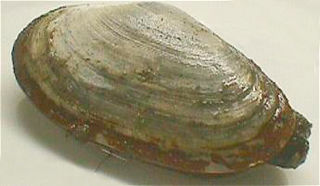
Soft-shell clams or sand gaper, scientific name Mya arenaria, popularly called "steamers", "softshells", "piss clams", "Ipswich clams", or "Essex clams", are a species of edible saltwater clam, a marine bivalve mollusk in the family Myidae.

Oberthür's grizzled skipper is a species of skipper.

Ammophila arenaria is a species of grass in the family Poaceae. It is known by the common names marram grass and European beachgrass. It is one of two species of the genus Ammophila. It is native to the coastlines of Europe and North Africa where it grows in the sands of beach dunes. It is a perennial grass forming stiff, hardy clumps of erect stems up to 1.2 metres (3.9 ft) in height. It grows from a network of thick rhizomes which give it a sturdy anchor in its sand substrate and allow it to spread upward as sand accumulates. These rhizomes can grow laterally by 2 metres in six months. One clump can produce 100 new shoots annually.
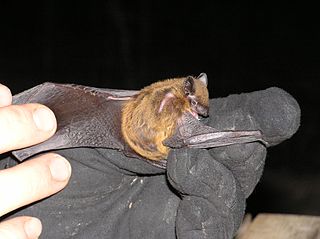
The evening bat is a species of bat in the vesper bat family that is native to North America. Hunting at night, they eat beetles, moths, and other flying insects.

Carcharodus alceae, commnly known as the mallow skipper, is a species of butterfly of the family Hesperiidae.

Eurydema oleracea is a species of shield bug in the family Pentatomidae and is commonly known as the rape bug, the crucifer shield bug, the cabbage bug or the brassica bug.

Micropterix aruncella is a species of moth belonging to the family Micropterigidae, which is distributed throughout Europe. The imago was first described by Giovanni Antonio Scopoli in 1763. This species is one of the best known members of the family, being found in a wide range of habitats from sea level to over 2,000 metres (6,600 ft); the only habitat not favoured by this species is dense woodland.

Muschampia floccifera, the tufted skipper or tufted marbled skipper, is a butterfly of the family Hesperiidae.

The European chafer is a beetle of the family Scarabaeidae. Formerly found only in continental Europe, this invasive species is now found at temperate latitudes in North America. The large, white grubs of A. majale feed on the roots of most cool-latitude grasses, both wild and cultivated. This has made the European chafer an enemy of lawns.
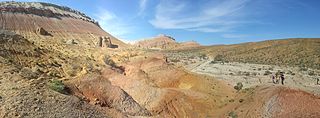
The Central Asian northern desert is an ecoregion in the deserts and xeric shrublands biome, located in the Central Asian countries of Kazakhstan and Uzbekistan. The annual precipitation ranges from 100 to 150 mm, the winters are cold at −10 to −15 °C and the summers hot at around 25 °C (77 °F). There are a range of habitat types including salt flats, clay desert, rocky desert and some sand desert. The vegetation consists of scanty xeric shrubs including Artemisia and Salsola. The fauna is varied, as well as mammals and birds, there are a large number of reptiles and many species of invertebrate. Some protected areas are included in this ecoregion but other parts are being degraded by conversion to farmland, overgrazing and poaching.

Arenaria norvegica, also known as Arctic, English or Norwegian sandwort, is a low growing plant in the family Caryophyllaceae, found in northwest Europe. The diploid chromosome number is 2n=80. There are two recognised subspecies.

Phyllopertha horticola, the garden chafer or garden foliage beetle, is a beetle from the family Scarabaeidae. Phyllopertha horticola was described by Carl Linnaeus in his landmark 1758 10th edition of Systema Naturae.

Sandy iris is a species in the genus Iris; it is also in the subgenus of Iris and in the Psammiris section. It is a rhizomatous perennial, from Central Europe, found in Hungary, Austria, Romania, Czech Republic and Ukraine. It has grass-like leaves, a short stem and pale yellow flowers. It has had a mixed origin and was once Iris humilis subsp. arenaria, a subspecies of Iris humilis, until it was reclassified as a separate species. But many sources still state that it is either a synonym or subspecies of Iris humilis. It is cultivated as an ornamental plant in temperate regions.

Peribalus strictus, common name Vernal Shieldbug, is a species of shield bugs in the family Pentatomidae.

Heterogaster urticae, common name nettle ground bug, is a species of true bug in the family Heterogastridae.




















